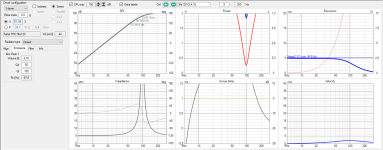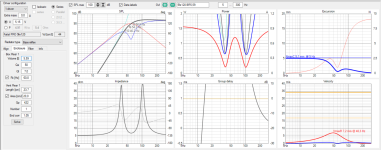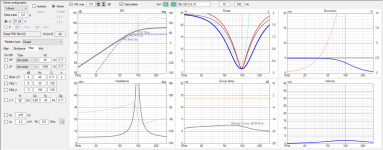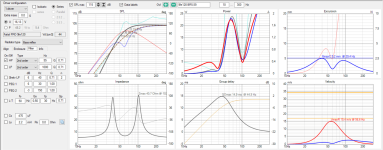Don't forget that the reduction in cone excursion does also help to improve midrange quality with reflex speakers, especially with small two way speakers ! Now you have to pick your poison..... or fnd a way to reduce the midrange leaking.Port can make noise and "leak" mids from inside the box, which means extra bass came with possible cost in system midrange fidelity. If goal for the system was high fidelity it makes no sense to sacrifice mids to get bass, right? To be aligned with the goal of high fidelity any and all trade-offs need to be outside of audio, in cost and complexity for example.
Regards
Charles
Changes in temperature and barometric pressure with a sealed box driver leads to coil offsets. Coil heating in the box, can also lead to an offset.
I design a slow leak (≤1mm hole drilled into the binding post plate) to negate this.
In the case of older speakers, the tweeter/midrange L-pad dials provided just enough air movement to achieve pressure equalization.
Yes, there is quite a lot to it. Excursion is less when tuning is around say 30-40Hz or so, around limit of musical content so that below this there is steep high pass filter that cuts the extra excursion below tuning without significantly taking out the content. Otherwise excursion could skyrocket instead. Take a small bookshelf speaker with 60Hz tuning and no high pass on the system (straight to amp), and it has wild excursion on 40Hz kick hits for example.Don't forget that the reduction in cone excursion does also help to improve midrange quality with reflex speakers, especially with small two way speakers ! Now you have to pick your poison..... or fnd a way to reduce the midrange leaking.
Regards
Charles
And there is more details that go to a specific room and positioning, tailor fitting: if there happens to be room modal peak at listening position at tuning frequency you need to cut it with EQ, even with closed box, so the port is now unnecessary. Imagine 60Hz tuned system and 60Hz modal peak at listening position, compromized mids and compromised bass, ouch. Blocking the port would be nice solution though, moving chair and so on.
It's a complex system, speakers and room. Perhaps most flexible setup is ported system with EQ, one can block the port and use EQ to tailor for the room and positioning. Only problem is that SPL might now be limited, but that's the compromise one took choosing too small system. Big enough system with ports or not, and EQ, and it should work fine, tailorable in situ.
Last edited:
Here is a comparison of the same driver in a closed and ported box with the same strength 80 hz drive signal. The ported system clearly has lower distortion and noise as well as about 6dB more output at the tuning freq.The difference is not subtle.

For sure, if excursion goes down so does distortion. Do the test with 40Hz signal, octave below tuning, and compare that? It shows you must use high pass filter, which is fine, just another thing that comes with it. Most music contains more or less all frequencies more or less simultaneously, so distortion reduction on narrow band is just that, it would reduce some, but not all, which kind of makes the high pass filter mandatory to really take out the excursion. Any excursion due to any frequency distorts the whole bandwidth of the driver.
Example to illustrate what it means when excursion skyrockets below tuning. Took random small driver as example. Here in this case tuning at 60Hz excursion of the system hits xmax with 5W of power, without high pass filter. In a closed box it can make similar output at tuning frequency, just takes more power. Extension gets much lower as well with closed box. The closed box would require very different crossover to maintain system response around the 60Hz, so there is a lot of difference between the two in system context. If the room has modal peak around 60Hz the closed box would work better and so on.


I'm not for or against either, both could have very similar response and sound for example and either could work better or worse in system context depending on many things. My point is bass can be achieved many ways, where the difference is mainly with the trade-offs. Select the trade-offs that suit best.
Example to illustrate what it means when excursion skyrockets below tuning. Took random small driver as example. Here in this case tuning at 60Hz excursion of the system hits xmax with 5W of power, without high pass filter. In a closed box it can make similar output at tuning frequency, just takes more power. Extension gets much lower as well with closed box. The closed box would require very different crossover to maintain system response around the 60Hz, so there is a lot of difference between the two in system context. If the room has modal peak around 60Hz the closed box would work better and so on.


I'm not for or against either, both could have very similar response and sound for example and either could work better or worse in system context depending on many things. My point is bass can be achieved many ways, where the difference is mainly with the trade-offs. Select the trade-offs that suit best.
Last edited:
For completeness same data as above but overlaid, so without high pass filter the closed box could perform better, be louder above and below and at tuning within limits of xmax, because it has less excursion 😉 In reflex box xmax exceeds below tuning without high pass filter.

With high pass filter engaged the situation reverses, excursion is truly less and reflex box gets louder within xmax.

It's likely possible to juggle a reflex box that is better than sealed even without high pass filter, but to really get advantage a high pass filter is required.

With high pass filter engaged the situation reverses, excursion is truly less and reflex box gets louder within xmax.

It's likely possible to juggle a reflex box that is better than sealed even without high pass filter, but to really get advantage a high pass filter is required.
Last edited:
Way back in the past, closed box speakers were frequent. What are the benefits of a port ? It goes further down. But is a ported enclose as punchy as a closed one ?
Acoustic suspension systems where the trapped air in the box provides most of the stiffness rather than the driver suspension were a good compromise when drivers were large with small deflections, speakers were large, records had little low frequency content and amplifiers had modest outputs. Modern drivers with high power handling, large displacements and smaller cone areas tend to benefit from stiffer suspensions. Indeed many drivers in sealed cabinets these days are not acoustic suspension.
As mentioned above ports offer increased SPL, lower bass extension and lower distortion at the price of larger cabinets, degraded transient response, port resonances and sound leakage out the port. For 3 ways the port resonances and midrange leakage occur at too high a frequency to be significant, the degraded transient response occurs at a low enough frequencies for there to be little transient information in music and the transient response of room resonances is a lot worse than that of a ported speaker. If the larger cabinet is not a problem then a ported cabinet is going to offer superior performance at a lower cost compared to an equivalent sealed system with more/larger drivers. It's why pretty much all studio speakers are ported.
For 2 ways the case for a ported system is less clear because port resonances and midrange leakage become a factor and the higher tuning of the port may be audible with music. However, the increased SPL and bass extension is a bigger advantage for small speakers because of their limited SPL and bass extension.
If a system has distributed subs the benefits of ports in the mains is reduced and a sealed system become a more reasonable choice.
You don't even have to do this. Loudspeaker diaphragms and enclosures are far from being completely airtight. Unless there are severe sudden (explosive) and huge pressure changes in your listening room there won't be any measurable voice coil offsets due to atmospheric pressure changes.I design a slow leak (≤1mm hole drilled into the binding post plate) to negate this.
If your listening room is a high altitude cable car I would recommend vented enclosure!
Had a B6-system (ported with tuned active HP a la Keele) for years. Very clean bass all the way down to the lowest piano key. In theory an in free field, closed box might be superior, however that advantage becomes completely moot when put in closed listening spaces.
I’m going out on a limb here but I think sealed or vented or whatever can be equally efficient.
There should really be no difference in efficiency/sensitivity between sealed and ported. However a ported system can reach 6dB higher max volume before reaching it's excursion limit provided it is properly high passed due to the reduced excursion at port frequency.
I am assuming sufficient clean power to be available. Due to reduced excursion THD should also be lower.
Only anecdotal but many years ago I saw a subwoofer group test online of various expensive subs and the only 2 which stayed at under 10% THD at all times were professional ported ones by Genelec and PMC (technically a T/L). These were also the cheapest ones tested.
In a nutshell Walter…..bass efficiency is the main benefit.Hi there,
Way back in the past, closed box speakers were frequent. What are the benefits of a port ? It goes further down. But is a ported enclose as punchy as a closed one ?
Walter
Depending on the tuning frequency and design, ported systems can be punchy.
Sealed systems when properly designed will almost always have better impulse response where the woofer is concerned so tighter, more accurate and articulate bass……the air spring within the box helps the driver stop and start more effectively.
Sealed boxes can be smaller for the desired bass response…..and need to be well built and braced due to the above. I prefer sealed systems personally…..but they’re not always practical.
The offset occur over very long time ?Changes in temperature and barometric pressure with a sealed box driver leads to coil offsets. Coil heating in the box, can also lead to an offset.
Drivers are mass limited on their upper corner, ( also inductance ) suspension limited on their low corner. Weak motors and soft suspensions are capable of wider bandwidth, but can exhibit issues with high power inputs.
I like that 😀yes absolutely.
I'll expand, morning coffee break 🙂
For example room modes have huge part of perceived bass performance, and as such it's part of playback system. I see two main issues with bass in general: effects of room modes and having enough volume displacement to get enough SPL capability and bandwidth.
If playback system consists of two small bookshelf type speakers there isn't going to be enough bass due to small volume displacement, so it makes a lot of sense to get some more by porting. Hense we see all commercial small speakers having ports (or passive radiator). On the other hand, if there was additional subs in the system to help extend the bandwidth, and help with the room modes, and give extra SPL capability, then the mains might be highpassed so port would be for nothing on the mains. Subs might benefit porting hough, if they are small. But if one got this far the system likely has an EQ and enough volume displacement so porting is not necessary which simplifies things. Can you find these kind of systems from hifi stores? probably not as they are hard to sell them, too hard to setup and too expensive for most, too much cabling, and so on.
In DIY land there is possibilities outside of commercial systems. Ports, or not having one, or any other design feature, comes with trade-offs and it's important to understand what those are and whether they are aligned with goal in mind. Port can make noise and "leak" mids from inside the box, which means extra bass came with possible cost in system midrange fidelity. If goal for the system was high fidelity it makes no sense to sacrifice mids to get bass, right? To be aligned with the goal of high fidelity any and all trade-offs need to be outside of audio, in cost and complexity for example.
So, is there any alternatives to get more SPL and bandwidth for lows than a port? Thinking for a second, wavelength of lows is so long one can get more bass just by adding more bass sources into the room. More sources can help even out effect of the room modes and increase volume displacement so SPL and bandwidth. Basically add few subs in addition to mains, to avoid ports. Where is the trade-off then? in cost and complexity mostly, which is nicely aligned with the goal for high fidelity. Bass system is now relatively independent of mains, which now can be optimized for mids and highs separately. It doesn't have to be subs, it could be just more volume displacement on mains, a three way mains with big bass woofer instead of a two way for example, but this doesn't necessarily help with room modes, unless it's gradient pattern system, which needs even more volume displacement.
If goal was to get some sound cheaply instead of absolutely high fidelity, then smaller and ported speaker system would be better suited no question.
So, it's important to have a goal for a playback system. The more one is into audio quality the more important system thinking becomes. One could include the music collection, "sound ideal", auditory system, the room, the aesthetics, everything, even cost and complexity to maintain realistic, but thorough, goal for a system. Power in DIY is the ability to tailor fit, and the system might end up with port, or no port. And, there is no reason to follow fashion, unless goal of the system is to satisfy ego.
Sealed systems when properly designed will almost always have better impulse response where the woofer is concerned so tighter, more accurate and articulate bass……the air spring within the box helps the driver stop and start more effectively.
technically that's just system Q isn't it, the driver main resonance where the box takes part as spring (and mass in case of ported). I can agree with this generalization but unsurprisingly there is more 😀
Ported box could be tuned to have similar Q as a sealed one, especially with EQ there is no problem to make one have pretty much the same impulse/frequency response as the other. But why do that, so this is just an edge case as an example. Both are affected by voice coil heating increasing resistance which reduces electrical damping affecting Q and so on, so it's another can of worms that makes them differ some. Driver could be more optimal for either, but if one has freedom to choose any driver it's just about the overall system and which trade-offs align better with goal in mind.
I think it's enough to have system Q something reasonable and it ought to work just fine, because in my experience the room can completely overwhelm the system resonance (Q). Even if cone stopped on a dime but there was a room mode at the resonant frequency the room would keep on ringing and in this sense all one has to do is to look at frequency response in room to see it's impossible to know what Q the bass box had. Even if the box Q was known, but you took two measures mic in different location the responses could look completely different what you simulated and between each other, totally masking the box Q making it at least seemingly irrelevant. Completely different thing if the space was very big, or if system is outdoors so another one for system design.
While there could be audible difference between the two in case there is no EQ and what the other pieces of the system are and how things are positioned and so on, I'm not that experienced to say how it truly is, but I'm sure I couldn't perceive small differences in my home because there is obvious issues due to room. Basically, modal peaks are so bad they mask mids making the whole system sounds bad, out of balance, until modal peaks are flattened out with EQ. So, here lies what I think what makes closed boxes punchier: they make wee bit less bass, which means wee bit reduced modal peaks, which appears as punchier sound because less booming and masking. But, you likely have more experience than I so can counter argument. Anyway, point is just to expand and give perspective so that everyone could think through their system.
I've had same drivers for many years and on three different boxes and all had the same issue with bass, because it's not box issue but room issue. Having DSP has allowed me to overcome that problem with all the boxes, after which there has been no meaningful difference between the boxes what comes to bass, all sounded punchy and bassy and all that, nice, given that they are tuned with EQ. Most notable difference between the boxes was "boxy sound" listening loud, which is by far least offensive with these current small closed boxes. The other two prototypes I've had were much bigger reflex boxes and would have required much more internal and structural damping, also issues with port noise. Those had too much bass so I just had to carve bass with EQ, so the big boxes basically made excess bass I didn't need so I could cut the size down instead and reduce the "boxy sound". And the reason I could this is the drivers are big 15" and there is enough headroom to play around. None of these boxes would work if I didn't have the DSP, and perhaps all of them could work just fine with more elaborate implementation, at least in some other space, and so on.
The takeaways for me are: as long as the bass system is sufficiently big and there is EQ, the boxes can be almost anything sensible. The smaller the drivers the more there is reason to have ports, just prepare to spend time to make them work without ruining mids, if bass box bandwidth extends there. Always use EQ 😀
it might be nitpicking, but to be precise around the helmholtz resonance the driver barely moves at all, so it won't need much help to "stop".the air spring within the box helps the driver stop and start more effectively.
It's the air in the port, loaded by (minimum) driver oscillation and enclodure volume spring that would need to be stopped.
Exactly!but unsurprisingly there is more
Which, to my ear, is the greatest disadvantage of ported sub enclosures. I believe that fast transient decay is equally important as fast attack times in the search for fidelity of reproduction.It's the air in the port, loaded by (minimum) driver oscillation and enclodure volume spring that would need to be stopped.
Yes, this is generally true.The takeaways for me are: as long as the bass system is sufficiently big and there is EQ, the boxes can be almost anything sensible. The smaller the drivers the more there is reason to have ports, just prepare to spend time to make them work without ruining mids, if bass box bandwidth extends there. Always use EQ
.... however... A vented box or PR can never really achieve a 2nd order high pass character. It is a 4th order system. With the right tuning, the system Q can mimic a 3rd order, and with a very gentle Q, this 4th order system can almost look like a 2nd order in terms of magnitude response. But in terms of phase and group delay, it will not be 2nd order.
And it is the group delay that is the real difference. The vented box system will always have a higher group delay than a sealed box. Perhaps low frequency group delay becomes audibly intrusive above some threshold. I am not sure what that threshold is, but a sealed box woofer sounds more natural to me. Perhaps it is possible that whatever the threshold might be, sealed box systems are below it.
There is a cost to this low group delay performance. I need 2 woofers in a sealed box to get the same SPL at Xmax as a single woofer in a vented box, although the total box size may be about the same... If not 2 woofers, then a larger woofer with twice the Vd. It is similar to the tradeoff that designers of open baffle dipole speakers must make, although not nearly as punishing. But it is definitely a cost.
j.
Yeah if closed box system sounds better it might be in the group delay, perhaps it hears even through the room. GD is affected >100Hz. This high FIR filters could help it though, no?
Another thought about vented box group delay: Adding a high pass filter below the vent tuning frequency makes the group delay worse. Much worse as a matter of fact.
- Home
- Loudspeakers
- Multi-Way
- Why are sealed box woofers out of fashion